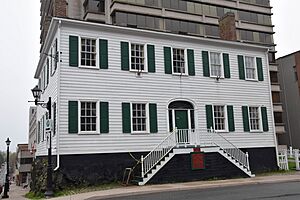Loyalist House facts for kids
Quick facts for kids Loyalist House |
|
|---|---|

The facade as seen from the north side of Union Street
|
|
| Location | New Brunswick, Canada |
| Nearest city | Saint John |
| Built | 1810-1817 |
| Original use | Private residence |
| Current use | Museum |
| Architectural style(s) | Federal Architecture |
| Governing body | New Brunswick Historical Society |
| Website | https://loyalisthouse.com/ |
| Designated | 1961 |
Loyalist House is a special museum and a National Historic Site in Saint John, Canada. It was once the home of the wealthy Merritt family. They lived there from when it was finished in 1817 until 1958.
In 1961, the New Brunswick Historical Society took over the house. They turned it into a museum for everyone to visit. You can find Loyalist House at 120 Union Street.
Contents
History of Loyalist House
The Merritt family were known as United Empire Loyalists. This means they were people who stayed loyal to Britain during the American Revolution. They originally came from Rye, New York, in the United States.
The Merritt Family's Journey
In May 1783, the Merritt family arrived in Parrtown, New Brunswick. About 6,000 other Loyalists came with them. Parrtown is now the southern part of Saint John. They had to leave their homes because of the American Revolution.
Thomas Merritt (1729–1821) was the father of the Merritt family in Saint John. He lived in Parrtown with his wife and seven children. Even though they started with little, the family soon became very important in the city. Thomas's children became very wealthy.
Building the House
David Daniel Merritt was Thomas's third son. He was a rich shop owner. David bought the land where Loyalist House now stands. Building the house started in 1810.
It took a long time to finish the house, until 1817. This was probably because of the War of 1812. At that time, the house was just inside the city limits. Union Street was the city's northern edge until 1889.
Because it was on the edge of the city, there weren't many buildings around. This allowed the Merritts to keep farm animals like cows and horses. They kept them there even into the late 1800s.
How the House Changed
When the house was first built, it was at street level. But as Saint John grew, the streets were dug lower. This made it easier for draught horses to pull carts up Germain Street. This is why Loyalist House now looks like it's sitting high above the street. You can see this in the picture at the top of the page.
The Merritt family owned the house until 1961. They lived in it off and on until Louis Merritt Harrison passed away in 1958. After that, Mr. Harrison's housekeeper lived there for a short time. In 1961, the house was sold to K C Irving and a partner. Then, the New Brunswick Historical Society opened it as a museum.
Architecture and Design
Loyalist House is often said to be the oldest building in Saint John that hasn't been changed much. Many other old buildings were destroyed in the Great Fire of 1877.
Federalist Style
The house was built in the New England Federalist style. This style was popular in the United States when the Merritts moved from there. The house has two and a half floors. The western side of the house was built on a strong stone and mortar basement.
Inside the House
The two main floors were where the family lived. They have the same layout and are almost perfectly balanced. These floors included the living room, dining room, kitchen, and a study. There were also four bedrooms and many hallways for the family and servants.
The living areas had a main staircase and a separate staircase for servants. There was also a bell system to call servants. The house had four chimneys, with two fireplaces in each. It also had thirty-one large windows. Gas lighting was installed, but the family later stopped using it. Not much of that system is left today.
Servants' Quarters
The top floor was for the servants. It had five rooms. People think one of these rooms might have been a dining room and lounge for the servants. The room next to it is small with many shelves. It connects to the other room with a window, like a bar. Later, the Merritts added skylights to this floor. But originally, it would not have had any windows.
Carriage House
There is also a carriage house on the property. It used to be twice as long as it is now. It held the Merritt family's carriage, sleigh, and their farm animals. The Loyalists used a heated frying pan to keep warm at night in the carriage house.
In 2017, Loyalist House was repaired and updated. This work cost about $600,000.
The Museum Experience
The Loyalist House museum uses most of the two main floors of the house. Other parts are used for offices and storage. The museum is filled with beautiful furniture from the Georgian and Victorian eras. These pieces come from the collections of the New Brunswick Historical Society, the New Brunswick Museum, and Kings Landing Historical Settlement.
Visiting Hours
The museum is open during regular business hours from Loyalist Day (May 18) until early September. It also opens for cruise ship visitors well into the autumn. You can take guided tours of the house at any time. These tours focus on the Merritt family and what life was like for wealthy people in Saint John during the 1800s.
Connections and Support
Loyalist House works with many heritage groups in New Brunswick. These include the Fundy Heritage Zone. It also has connections with the federal and provincial governments.
See also

